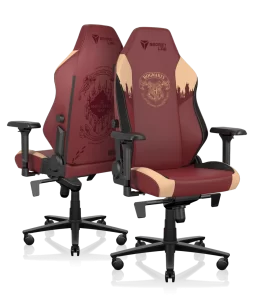“Crimes of Grindelwald” Set Visit Interview: Martin Foley
On the set of Fantastic Beasts: The Crimes of Grindelwald, Martin Foley, supervising art director, spoke with us about the film’s incredible sets. Foley has been working on the Potter films since Harry Potter and the Prisoner of Azkaban. While watching Crimes of Grindelwald, we’ll find ourselves whisked away to a variety of magical locations across the world. New York, Paris, the Circus Arcanus, and familiar places from the original Potter films will all have their place in this movie. Foley also gave us some insight on where we’ll find Newt, Tina, Dumbledore, and the others when the film begins.
Martin Foley: So Stuart Craig, our designer, who, obviously, designed all of the Harry Potter films, as well as Gandhi and The Eleplant Man and Dangerous Liaisons [and] The English Patient… I can go on. Anyway, he[‘s] unfortunately not here, but Stuart called me. Last July, he started thinking about this. [He] went to Paris. We knew that much. We knew that it was going to be set in Paris.
So he went to Paris to start doing some recs, and then properly, we [the] started art department in September last year. So we’ve already been on it over a year, and basically, the film kicks off pretty much where the last film left [off]. A few months have passed. Like, six months have passed or so. So Newt has published his book, Fantastic Beasts and Where to Find Them. And that’s where we are. But where we start with is in the basement of the MACUSA building.
So we’re back in New York in the basement, in the cells, and we find Grindelwald in the cells. So as you can see, we’re not building that much. There will be a lot of digital effects because there are hundreds of prisoners there watching him. And he’s a bit of a hero in the criminal underworld and [with] the under beings and Dark Magic world. They rate him. So as he’s getting transported from the basement up to the roof of the MACUSA [building]… Basically, they’re going to send him back to Europe to be tried for his crimes in Europe. The Americans want to get rid of him. He’s a bit too hot to handle. As he’s going through here, they all start cheering, and that is quite a high[ly] volatile situation. He takes [an elevator] up to the roof. This is the very roof of the MACUSA building. So it’s a real building in New York, the Woolworth Building. And we shot it on the last film. But now we’re building on the stage that roof space. And in there, he comes up in the [elevator] and there’s a magical carriage, which is actually pulled by Thestrals, which is a throwback to our previous films. Very exciting. And they’re going to fly, basically, just drive out the top of this building and plummet. But then as they’re plummeting, also, their wings open and we’re on this roller coaster ride. And as he’s going back, I’m not going to get into the details, but an escape plot occurs here, and it’s [a] very, very high-[stakes], big action sequence at the beginning of the film. It’s going to blow everyone away, hopefully, across the skies of Manhattan, the Hudson and stuff. And we all know that he does escape.
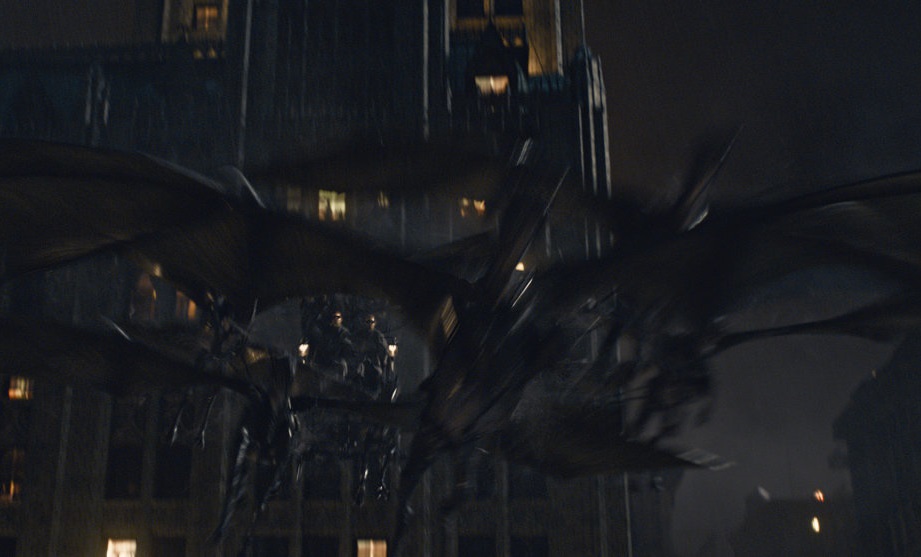
We come to Credence. He’s basically trying to find out who he is. His key out of New York is with the wizarding traveling circus. And they’re not really the standard happy circus. It’s more of a freak show, a sideshow, quite dark circus. And so he gets a job with them, helping them. So that’s the beginning. And then we find Newt. He’s in trouble with the Ministry again. He’s trying to travel internationally, but they won’t let him because of what happened last time. And so we find him in the Ministry of Magic. So it’s a very exciting moment that will be in the film for [die]hard Potter fans, is that we go back to the British Ministry of Magic, and we created big sets on there and new sets, new elements, big sweeping corridors, all of the green tiles, and it was really fun doing that. And then he leaves there. He meets up with a certain young Professor Dumbledore who[m] I think you all know about.
And they meet and it’s not explicit that he’s working for Dumbledore. He kind of figured it out, but he didn’t know he was being used by Dumbledore. But Dumbledore is like a chess master, as is Grindelwald. The two are rivals. So that’s the plot, really. Those two are playing and using people, one for good, one for bad, if you like. But Newt gets wind of this after what happened the last time. And they have it out. And they meet up in the streets of London. So all our London elements. We couldn’t afford to build the whole of New York, the whole of Paris, and the whole of London [for] this film. So London is very curbed, cleverly set in the mist, and well, Dumbledore actually brings in a mist. He brings in a fog. This image here is Dumbledore on top of St. Paul’s [Cathedral], and he ushers Newt up. There’s a little glove there, and he points out to Dumbledore and Newt shakes the glove and it takes him up to him and they have this conversation on the roof of St. Paul’s. And they’re being followed, so [Dumbledore] brings in this mist. And they keep Apparating and walking through the old vignettes of foggy London, and we find they’re being followed. And so we won’t go into the details, but it’s good and dark.
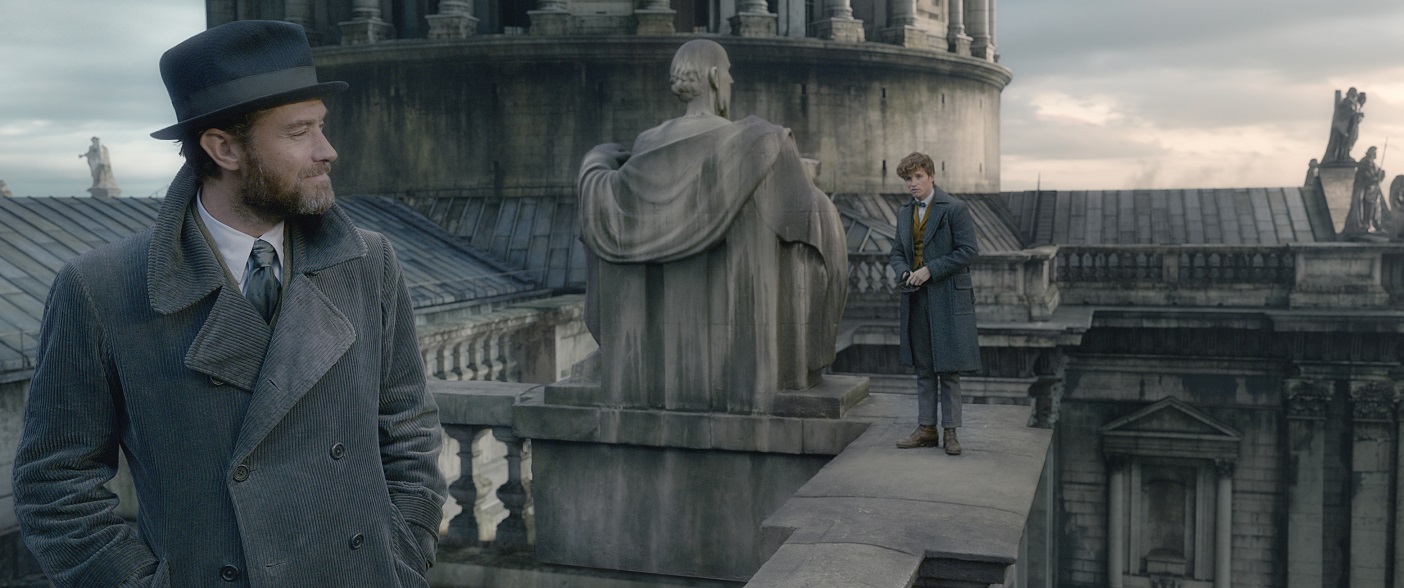
Newt heads home after seeing Dumbledore. This is where he lives, somewhere in South London. And it’s quite an average-sized property, but downstairs, he’s used [a] bit of magic and has extended his Georgian basement into this amazing magical menagerie hospital. So it’s a bit like a physical extension of his case. The case is what he takes around. And he has those different environments for the creatures. So they’re kind of thrown together. They were canvas and kind of a bit Heath Robinson. But the creatures felt at home, and they are more expansive for them. And this is like a physical, more architectural version. So in each of these alcoves, there will be a new environment. So there will be a[n] Augurey or some new creatures, some creatures from the last film. And these concepts… some are early, some are late. This is almost a still from the film, which we’ve added in the environments. And this is actually a built set. So we built this huge basement set. Well, maybe I won’t pick it up. [laughs] But you can come over and see it in a bit.
And it’s interesting, because Stuart often returns to themes throughout his films. And there is a staircase [that] is reminding me slightly of the staircase at Hogwarts. Yeah, the moving staircases. And Newt, obviously, went to Hogwarts, and maybe that’s just part of his nod to that. And then just to blow everyone’s minds, Stuart decided to put the shed in the middle of it, which doesn’t make any sense because that’s inside his case. And his case is there. And we have a lot of fun discussions about how is that possible?
David Heyman and everyone [were] like, “Well, I just don’t understand it.” And Stuart said, “Yeah, but it looks great.” So it’s staying. And so there it stays. So he keeps a lot of his herbs and his potions and stuff inside there. But that’s a really beautiful set. And he’s also got an assistant, who… Well, I don’t know whatever that is, but it’s quite a nice relationship between him and his assistant. And it lets Newt go off on these adventures and know that his animals aren’t just starving. They’re being looked after. And yeah, so there'[re] different creatures in there. And you go into the environments and tend to them. I’m not sure how many creatures I should say.
Press: Say all of them.
Martin: [laughs] Yeah. I don’t want to give too much away. Meanwhile, the circus that Credence joined up with in New York has arrived in Paris. And [these are] some of the concepts from that. And there'[re] these under beings. There'[re] various creatures and under beings and slightly non-magical Squibs or magical creatures. And so there'[re] outcasts, basically. And they put on a show. And what’s going to happen is, we visit Paris, and it’s 1927 Paris. It’s very sooty. It’s very dark. We couldn’t shoot in real Paris full on. We have shot loads of plates, and we’ve gone and scanned them and done an awful lot of research there. And we shot skylines and stuff. But to actually take our unit to Paris is a big number. But more importantly, Paris is clean. In the ’70s, they started jet washing all of the walls. And so it’s this beautiful pristine place. And then on the ground floor, [it] is all very modern and difficult. It’s got traffic lights and modern things. And so it just becomes a number. So as we do, we built most of the bits we needed. So this is the set on the backlot, which we’ll go and see.
So the green line represents how high we built. And we took our New York sets, and stripped [them] all off, kept a lot of the scaffolding and the roads [and] repurposed [them]. We laid different pavements. And for every one window in New York, we’ve got, like, three in Paris because of the scale. New York has these massive windows, these big panes in Manhattan. And Paris is so much more detailed. There’s a lot more history of architecture. I mean, because the Americans do classical architecture, but it’s big and it’s bold and brash, where this is the real deal. So it was a great thing for us to build. Hopefully it works when you go out and have a look at it.
So the circus gets set up. But before the circus, we see real No-Maj Paris. So there'[re] all of the French people wandering around. And then we see young Credence. He goes through a statue, and it’s a bit like the wall by the Leaky Cauldron and the wall inside Diagon Alley or the telephone box inside the Ministry. It’s that magical platform nine and three-quarters. So there’s this beautiful statue in the street, and it’s a bronze statue, and as you approach as a wizard, she moves her leg and you pass through underneath the base. And we had that hand carved and built here. And you’ll see it out there on the top of the steps. And when you go through the statue, you’re in a wizarding part of Paris. So we’re having fun now, redressing shops into wizarding shops. So it’s a bit like the French version of Diagon Alley, [on] a slightly grander scale, but again, it’s that tying that thread back to the other films, or forward to the future films, if you like. Yeah, so they [unintelligible] in the circus. Then the circus arrives, and Credence is, like I said, using this as a job. But he meets some characters in there that he likes and befriends.
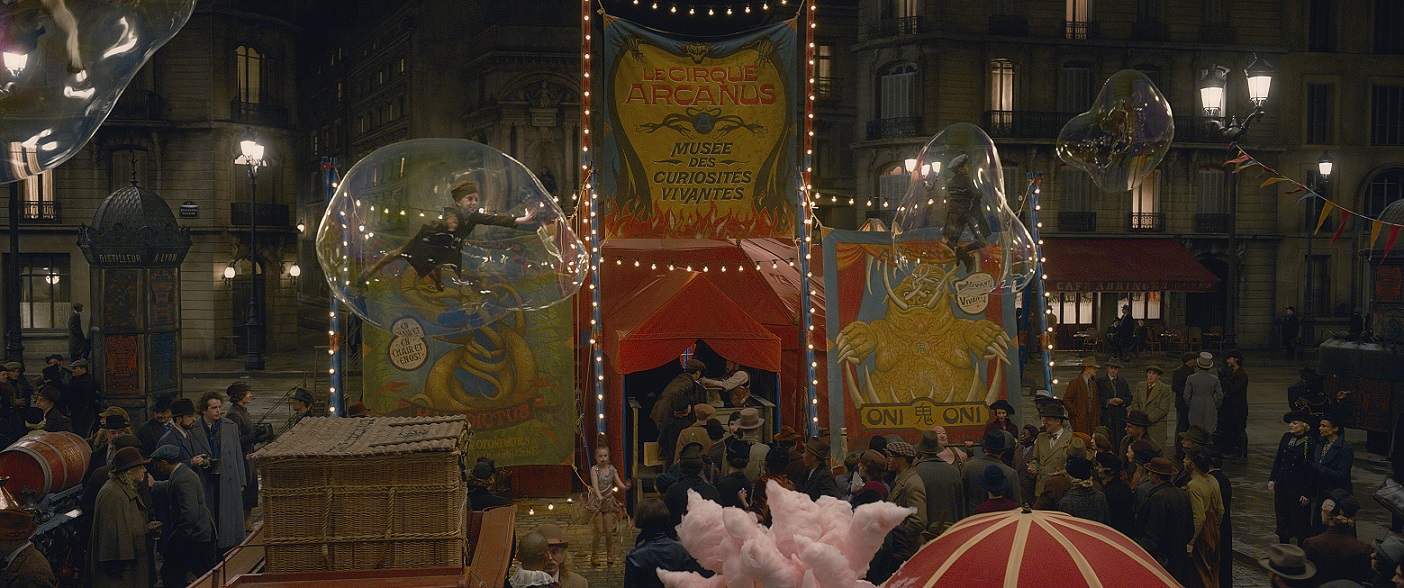
Meanwhile, Tina is now a reinstated Auror. She is back, much stronger, much more confident. She’s got her job back. She’s happier in this film. And she’s more strident and she’s gone to Paris. Newt wants to go and meet Tina. They’ve kind of fallen out through miscommunication. I don’t know how much you know of this stuff. Yeah, we won’t go into great detail, but it’s complicated, as all relationships are. And Jacob and Queenie also head to Europe for their own reasons, which I won’t go into. But they all now find themselves there because of each other. It’s not just a coincidence. It’s not like, “Oh, you know.” There is a reason why they all end up there. Because Grindelwald has gone there as well. And he’s kind of hiding in plain sight.
So that’s why we’ve got Paris. And so we basically repurposed it. So we’ve got the high end of Paris, the boulevards, the avenues, and then we’ve got the Montmartre steps and the more kind of mid-level town. And then we’ve got the really old part of town, lots of little alleyways and lanes. And there’s even a character called Nicolas Flamel, and he’s an ancient wizard, and it was interesting because when we were reading the script, Jo would write where these characters are set, and he was on rue de Montmorency. And we went there, and actually, Nicolas Flamel is a real person – he was a real chemist – and he lived there and he was quite a famous person. And so she’s really thought about all of these different parts of Paris and tied them all in. So that was a fun link. But his house looked nothing like Stuart designed, obviously. [laughs] So he’s gone for this really old house that’s kind of like a nail house. It’s just left there, and Paris has developed up around it.
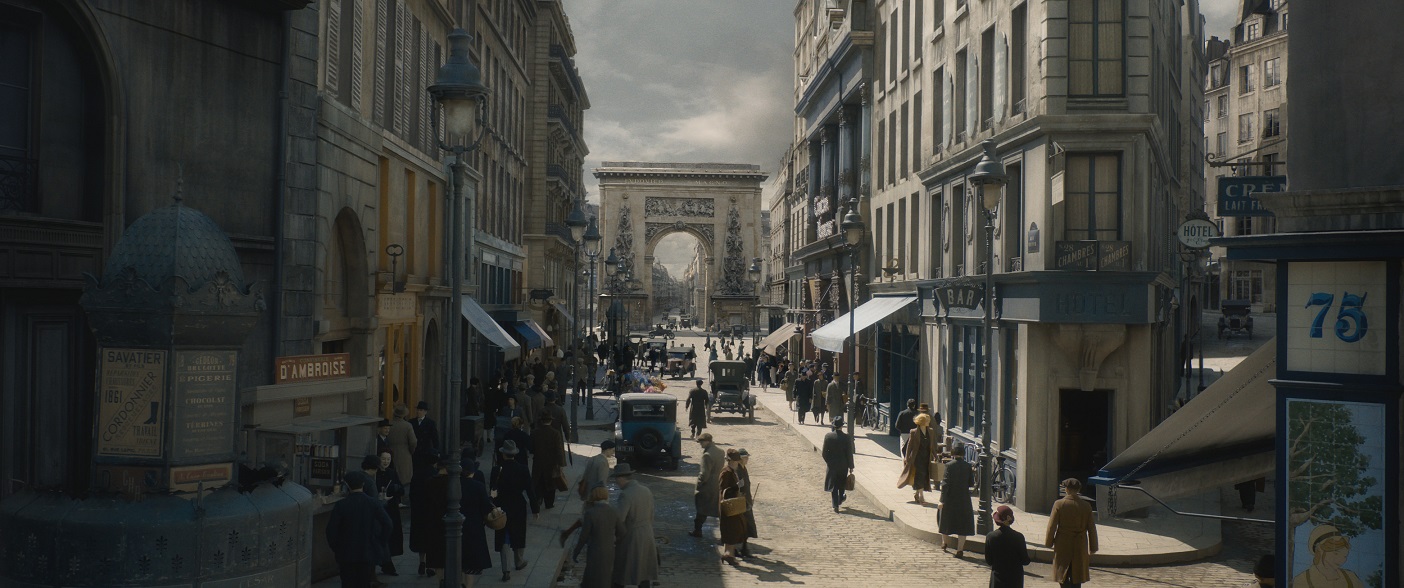
You’ve got the British Ministry of Magic. Theirs is the French Departmental Affairs of Magic, I think it’s called. It’s changed names a few times. We’ll get you the proper name. And all Jo said in the script was that it was this kind of nouveau building and underground. And the problem with being underground is, there’s no light. And nouveau is all about light and nature and [these] beautiful organic shapes. And when you’re underground, it’s just like a big cave. And so Stuart decided to ignore pretty much the fact it was underground. He’s put it underground, but it has a magical glass roof. And there'[re] all these domes, and it’s very similar to the gardens. There’s a building in Paris it’s quite similar to. But on the domes, there are projections of magical creatures. And we sculpted all of these beautiful statues, which are [a] bit like Marianne, the French statue and the symbol of France. But there are wizarding takes on that. So this parallels with the world above, but below. So they go down, and there'[re] various chase sequences and action that happens down here. And there’s intrigue and different departments but all in this beautiful French style, which I hope you'[re] going [to] see a bit of today.
So although we’re in Paris, we won’t [have] big shots of the Eiffel Tower. It will be just like, “Oh, by the way, there’s a bit of the Eiffel Tower.” We just happen to be in Paris. We’re trying to keep it grounded and real. This is something that Stuart has always tried to do with all of the films, is the more reality and authenticity we put into the films, when someone pulls a wand out and does a spell, you just accept it because you’ve accepted everything else. If everything is fantastical, you just switch off. You just think, “Oh, it’s just all fantasy or all CGI.” So we try and give as much authenticity to everything as possible.
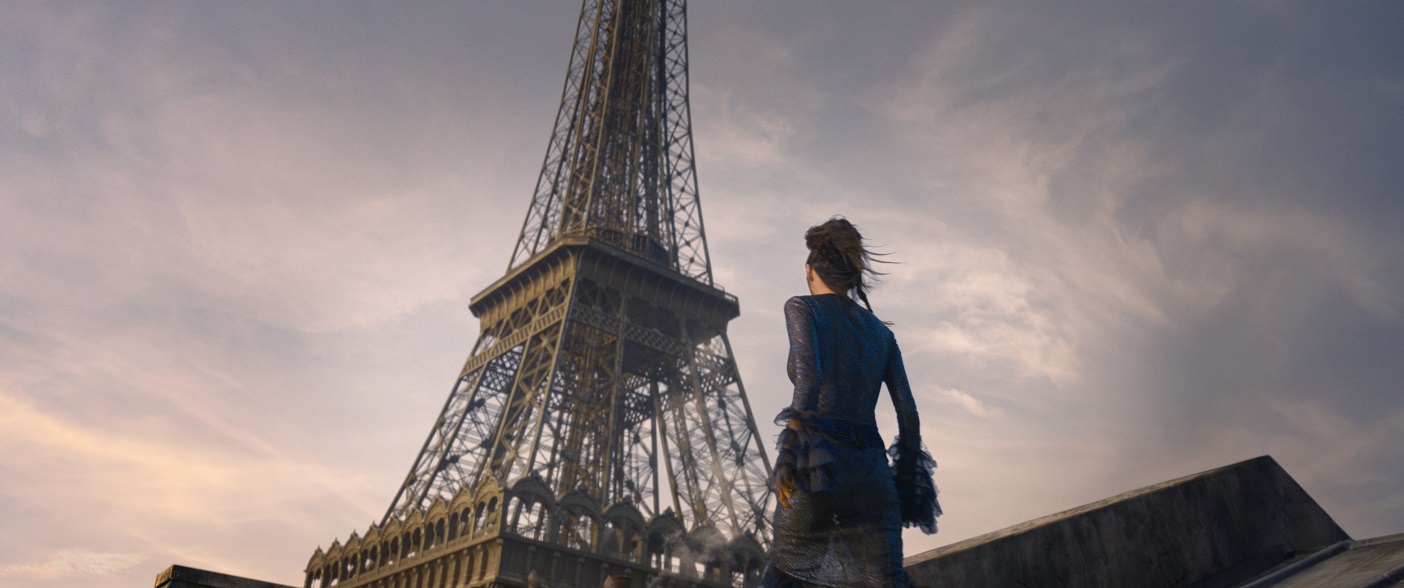
These are some banners. Grindelwald is trying to advertise. This is later on. I can’t get into details. It’s really complicated. But it’s a beautiful visual of Paris being covered in fabric, just indicating something that only wizards can see. The Muggles don’t notice it. They carry on about their day. This is Place de la Concorde. So again, we couldn’t really go to Place de la Concorde. It’s one of the busiest road junctions in France. So we’ve built this middle bit, and it will be all with green.
Press: Is this underground amphitheater part of the Paris?
Martin: Yes. So that’s the sewers in Paris, but then there’s a big bit at the end, [which] is basically a gathering of wizards, if you like. And it happens in an underground amphitheater under Père Lachaise, the very famous cemetery in Paris.
But it’s got [these] beautiful old tombs and stuff. But again, [it’s] difficult to shoot there. So we’re taking elements of that, which we’re scanning, and we’re building small elements here, but we’re also shooting in Highgate [Cemetery], the central tomb at Highgate. We use that as part of our tomb complex. So this will be aboveground. None of this exists in Highgate. We’ll be adding in these statues. And then underneath, there’s this big amphitheater. You can see, like, 2,000 people. And it’s almost like a rock concert that Grindelwald is giving to persuade wizards that what he’s doing is fair and just. He’s not overtly aggressive or violent. He’s just using his wit and charm.
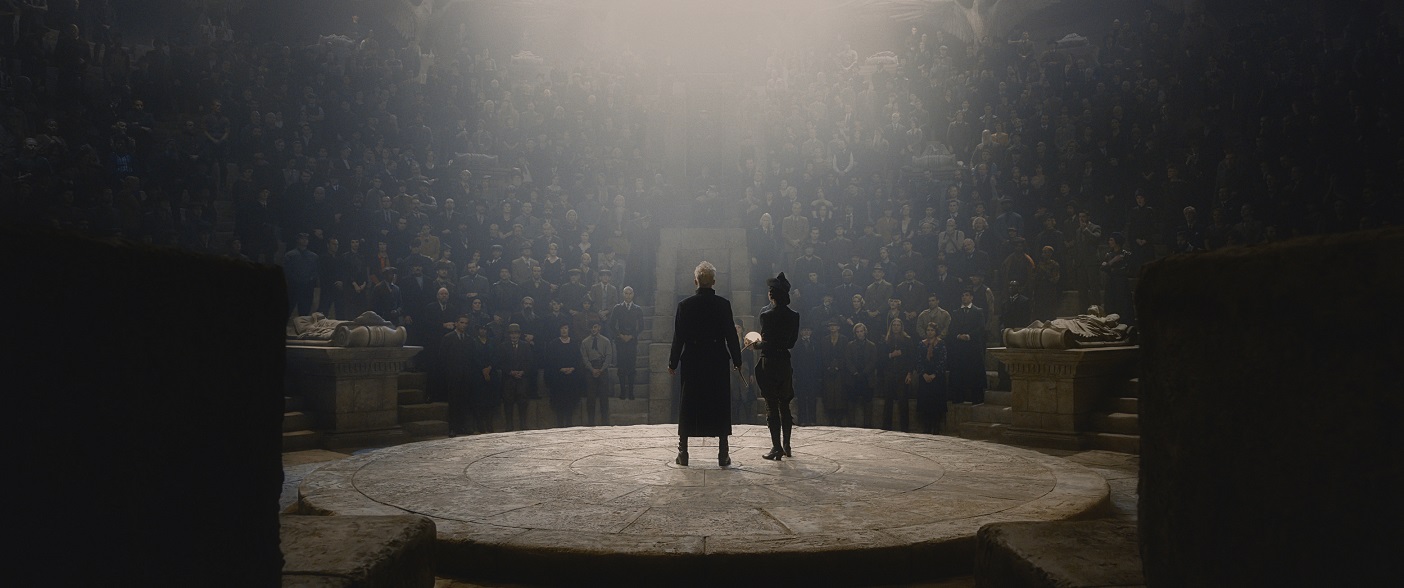
And some of that makes sense, but it’s just, how far is he going to go with it? And that’s what we don’t know, do we? Because obviously, they have a [unintelligible] power that could go completely opposite, which is his real aim. But at this age, he’s being a bit of a charmer. So yeah, that’s probably the main story arc, really. It’s his persuasiveness. He’s not just all doom and gloom.
And then there'[re] some flashbacks to Hogwarts, which is really exciting, I think, for the fans. I won’t go into too much detail of whose flashbacks and when, but we rebuilt certain classrooms and we revisited some locations we show on Potter. So it’s quite nostalgic. I started on Harry Potter [and] the Prisoner of Azkaban, and some of the sets we built on that we built again, how[ever] many years later. So I’ve been doing Harry Potter for 17 years, I suppose, on and off. So yeah, it’s quite amazing to rebuild these pieces and then have Dumbledore, albeit a young Dumbledore, and then the kids. And Jo came and saw that set and was like, “Oh yeah, this is…” It’s amazing, really, to revisit some of those things. And there'[re] the grounds of Hogwarts as well. We have a young Newt cast. So that’s exciting.
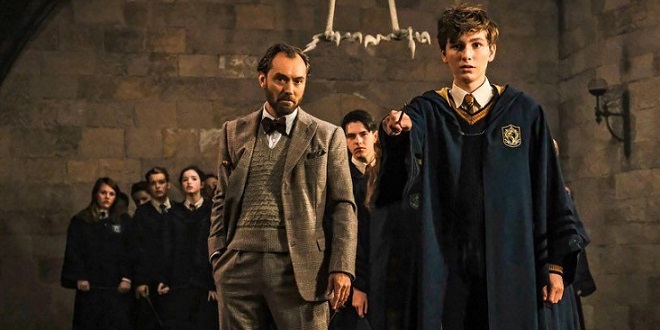
Press: What are the biggest differences between the Hogwarts that we’ve seen in the previous films and the Hogwarts we’re going to see in this movie?
Martin: Well, there won’t be that much [of a] difference because, obviously, Hogwarts is very old. 800 or whatever years old. [Editor’s Note: Hogwarts was founded around 900 AD, making it around 1,000 years old in the early 1900s.] And it’s only 70 years [between the Fantastic Beasts series and the Harry Potter series]. So it wouldn’t change now if you went really that [far]. So I would say, [in] every film, whoever the professor is (of Defense Against the Dark Arts), their classroom has its own appeal and their own things. So young Dumbledore has his own dressing, if you like, for him specifically. But the classroom is the same.
Press: In terms of scale and the number of sets that you’ve built, is it a bigger movie than the last one?
Martin: It feels like it. Yeah, the numbers should be the same-ish. And I’m not just being biased. But as we go on, there'[re] more levels of layers of detail. And there’s a lot more variety in this one. The last one was a lot in New York, obviously. [With] this one, because we have London, Paris, and New York, plus the layers of going back to Hogwarts… They’ve done an amazing job, so Stuart is really pleased. And he’s really on good form, really happy about it all.
Press: Do you know in advance for the next film what you should and shouldn’t destroy, set-wise?
Martin: It’d be good, wouldn’t it? You would think that would be really sensible. No. Jo can’t tell us too much in advance of the next film or the next film. So [from] the last film, we’ve kept everything from New York. We’ve got it all. And we were waiting for the trigger. And everything [being] where it is, New York is not really what we’ve done before, which [are] the docks we ended up building here. We’d done it at Cardington [airship hangars, in Bedfordshire] last time, and then that wasn’t available. So it was like, “Great.” So we had to rebuild it. But it means we get to improve it and change it. But yeah, they’re going to keep everything from the French one as well. So we’ll have this huge archive, and I’m sure that will get shared with everyone at some point, like the Tour. There will be some way of sharing that with the fans in the future.
Press: In terms of magical creatures, what is sort of the percentage we’re going to see compared to the last film?
Martin: I don’t know yet. It’s fluctuated throughout, hasn’t it?
Press: I don’t even know if you can be specific about that.
Martin: No, it’s tough. Yeah, it’s a good question. But there are some big creatures in this that work their way through the story. And Newt is having to cope with them and trying to look after them and save them, as well as the other arcs. There are so many arcs to these films. And creatures are definitely still very much part of it. There'[re] a lot of birds. Jo likes birds. There'[re] a lot of birdlike creatures, it seems. But yeah, no, there'[re] a lot of creatures. So this isn’t the place, really, to see them, is it? It’s more of visual effects downstairs. So Stuart designs everything. He also has designed all of the creatures, historically, as well. And on this one, he’s still doing that, but [for] a lot of it, he’ll set the ball rolling and then they’ll go with it and then come back to him and just touch base with him because the creatures are like characters. They’re [unintelligible]. They have to be so finely tuned to get it right that it’s a full-time job just even thinking about one creature. And also, unlike the Potters, where we did a lot of more animatronic maquettes and creature effects – like the hippogriff was built [with] each individual feather or what[ever] – [for] all [the] films now, it’s just the demand on the creatures. You won’t visit visual effects, but their walls are covered in creatures. Their walls are covered in creatures. I don’t think we have any up here, do we? So no, not anymore. But there are lots of creatures in it.
Press: I was wondering which of these was the most creatively challenging to take on?
Martin: Yeah. Well, we all work for Stuart still. That’s the thing in visual effects and the art department, props, set decorating… It’s amazing. He never tires of it. And so I don’t know how much isn’t [unintelligible] to him. I think he loves it. But for us to build what he draws is the challenge. And so the French Ministry was really difficult because it’s a curved balcony and steel and glass, and in films, we tend to build most things with plaster and scaffolding and wood, and this is all glass and steel. Engineering-wise, there'[re] a lot of calculations to do on that and what bits we needed to build and how much we could build and get ready. So that was a challenge because of the really big sets. Like the amphitheater, which is a huge set, is actually quite simple. So it’s not just scaffolding. So I’ll say that.
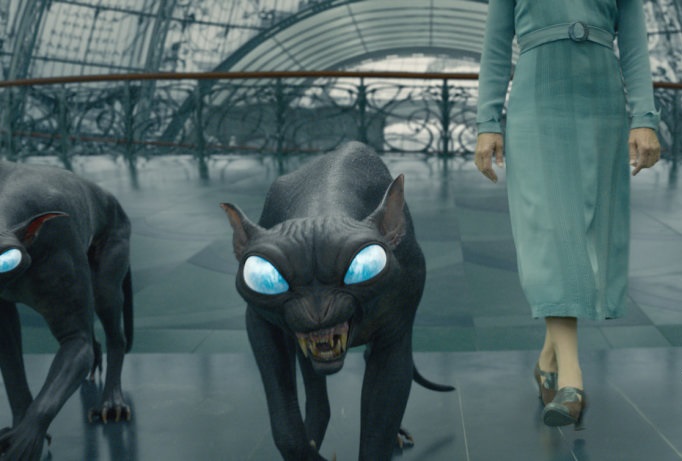
Press: Do you have a favorite that you’ve done?
Martin: On this one? Yes. It’s not here. It’s a part of Hogwarts that we’ve never seen before. It’s like a secret cubbyhole space where Newt keeps some things. And it’s [a] tiny set, but it’s really cute. My favorite set on the Harry Potter films was Dumbledore’s, because of the layering and the three [levels], and it reminds me of that but on a tiny scale.
Press: Did you get a chance to go next door and steal some props?
Martin: Yeah, we did. I don’t want to say which ones, but we did. And some of them we couldn’t because they’d be on tour around the world in this Harry Potter exhibition, so we had to remake some, which is interesting. And how those processes have changed. One was a piece of furniture, and on the film, I remember the carpenter made it by hand. And he’s now one of our deputy construction managers. And that’s how things have changed. And they laser cut it and send it out. Whereas he did it all by hand. So things have progressed in every department in terms of technology and that. But yeah, wherever we can go, we’ll go and borrow something, definitely. There’s just a gap and they have a little sign, and then we put it back again. So yeah, I mean, I think people are talking about that a lot, the links.
You know Hogwarts, so everyone is focused on that, which is great. But the story is plowing on. It’s just broadening the world. And having a French wizarding street is just really exciting for us, new shops and new brands and new franchises of the French versions of the English things, like the wizarding supplies and all of that. And so when you go down, they’ve just started dressing it, so you might see some of that. And you’ve got to imagine it at night lit up and every stall, and it will be filling the street as well. It won’t be just as you see it because, obviously, when you go into film sets, sometimes they’re [a] little bit underwhelming.
Press: London has King’s Cross as a sort of focal point for Harry Potter fans. Is there somewhere similar in France that you think will become sort of a place that people want to visit after seeing this film?
Martin: That’s a good question. We’re all over it. There’s one little thing like in the Ministry of Magic in London, the red telephone box, and you go down in Whitehall, and so if you’re ever near a red telephone box in London, you think, “Oh, is that…?” And the French Ministry has something similar. So I’m hoping that that will translate into… There’s a little square in Paris. And we’ve put that in and re-created that. But we didn’t go for the iconic parts, because it’s too obvious. It’s like, “Oh, we’re in Paris. It’s all where you eat baguettes and sit in front of the Eiffel Tower.” So we just happened to be in Paris in 1927. So I mean, that Place de la Concorde is a very famous part of Paris. So you can go and sit on the wall and imagine they’re all there.
Read the rest of our set visit coverage here.
This interview has been edited for clarity. Additional formatting provided by Felicia Grady.

